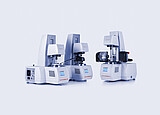Accessory for MCR:
Rheo-SANS/SAXS
- Accessory for “Structure Analysis and Rheo-Optics”
- Small-angle scattering for nanostructure analysis
- Temperature range from -50 °C to +300 °C
Understanding the behavior of complex fluids under flow requires knowledge of structural changes at the micro-structural level. Anton Paar developed a specialized measurement setup that allows the usage of the renowned MCR rheometer technology in combination with instruments for Small-angle X-ray Scattering (SAXS) and Small-angle Neutron Scattering (SANS) at x-ray or neutron beam lines. With the Rheo-SANS/SAXS accessory from Anton Paar, all rheological test types can be performed simultaneously with real-time small-angle scattering. It consists of a radiolucent convection temperature device and specialized measuring system for all kinds of samples from liquids to powders, and even films.
Key features

Combination of SAXS and SANS measurements with all rheological test types
The Rheo SANS/SAXS accessory combines a fully functional MCR rheometer with SAXS and SANS for measurements at temperatures from -50 °C up to +300 °C. You can perform all rheological test types with simultaneous and real-time small-angle scattering. Various beam positions with respect to the shear flow provide scattering information at different planes. Available measuring geometries are concentric-cylinder (max. cup diameter 50 mm) and parallel-plate (up to 50 mm diameter) systems made from different materials, as well as DMA and extensional fixtures (SRF, SCF, UXF, SER). For extraordinary installation conditions, e.g. limited space in the beamline, special rheometer types are available. Also, individual measurement setups designed and adapted to your specific needs can be implemented on request by our experts.

SAXS meets rheology for shear-induced nanostructure analysis
Small-angle X-ray Scattering (SAXS) and Wide-angle X-ray Scattering (WAXS) are powerful methods for the nanoscale characterization of density differences in all kinds of materials (e.g. biomaterials, colloids, suspensions, nanocrystalline polymeric materials). Gain information about the shape and size of macromolecules, characteristic distances of partially ordered materials, pore sizes, and other data. Rheology combined with SAXS techniques enables investigations of shear-induced nanostructure changes in complex samples – from flow- and temperature-induced crystallization to shear banding and many more. All irradiated parts are made of polycarbonate by default; other materials are available on request (e.g. polyimide). The irradiated parts can be exchanged in less than a minute.

SANS and GISANS – characterization on the nanoscale
Small-angle Neutron Scattering (SANS) is a powerful method for the nanoscale characterization of all kinds of materials. Neutrons are scattered by nuclei or by the magnetic moment of unpaired electron spinning in magnetic samples. Unlike an X-ray photon with a similar wavelength which interacts with the electron cloud, neutrons interact with the nucleus itself. Since the neutron is an electrically neutral particle, it deeply penetrates and therefore probes the bulk material. A combination of Rheo-SANS with dielectric spectroscopy measurements is available.
A special measuring setup for grazing-incidence small-angle neutron scattering (GISANS) or neutron reflectometry for thin film characterization can also be integrated.
By default, irradiated parts are made of titanium; other materials are available on request (e.g. quartz glass). The irradiated parts can be exchanged in less than one minute.

Unique measuring technology for complex applications
The unique Rheo-SAXS/SANS setup from Anton Paar is used at facilities around the world for sophisticated state-of-the-art research and development. SAXS and SANS both require special sources for X-rays (synchrotrons) or neutrons (reactor or spallation source), which are typically only available at large research facilities.
Typical applications:
- Characterization of polymer solutions, melts, films
- Life science materials
- Determination of (shear-induced) nanoscale structures in colloids of all types
- Flow- and temperature-induced crystallization and shear banding
- Information about the shape and size of macromolecules
- Characteristic distances of partially ordered materials
- Studies of proteins at physiological conditions
- Time-resolved studies of reaction kinetics
Anton Paar Certified Service
- More than 350 manufacturer-certified technical experts worldwide
- Qualified support in your local language
- Protection for your investment throughout its lifecycle
- 3-year warranty
Documents
Compatible instruments
Similar products

Accessory for MCR:
Particle Imaging Velocimetry

Accessory for MCR:
Rheo-Microscope

Accessory for MCR:
Rheo-SALS

Option for a Rheometer with two EC Drives:
Rheo-Microscopy Setup

Accessory for MCR:
Dielectric Spectrometer

Rheo-Confocal Microscopy:
MCR 702e Space MultiDrive and Rheo-Optics

Accessory for MCR:
Polarized Light Imaging

Optical accessory for MCR:
Rheometer-Infrared Spectrometer Adapter









